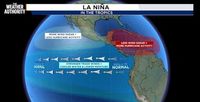La Niña, the cooler sibling of the infamous El Niño, has officially returned, stirring up conversation among meteorologists and residents alike across the United States and beyond. The National Oceanic and Atmospheric Administration’s (NOAA) Climate Prediction Center announced on October 9, 2025, that La Niña conditions had emerged in the central and eastern equatorial Pacific Ocean, characterized by below-average sea surface temperatures. While this climate phenomenon is a natural part of the El Niño-Southern Oscillation (ENSO) cycle, its timing and predicted weakness this year are prompting experts to watch closely, but not panic.
La Niña, as explained by NOAA and echoed by the Associated Press, is defined by a cooling of certain parts of the central Pacific Ocean by at least 0.5 degrees Celsius (0.9 degrees Fahrenheit) compared to normal. This cooling disrupts typical wind and current patterns, resulting in global weather shifts that can persist for months or even years. ENSO cycles, which include El Niño, La Niña, and neutral phases, don’t occur on a strict schedule but tend to repeat every two to seven years.
According to the Climate Prediction Center, "La Niña conditions are present and favored to persist through December 2025 - February 2026, with a transition to ENSO-neutral likely in January-March 2026." However, this year’s event is expected to be weak and short-lived. Michelle L’Heureux, NOAA’s lead scientist on ENSO, noted in an email, "There is a three out of four chance it will remain a weak event. A weaker event tends to exert less of an influence on the global circulation, so it’s possible there will be surprises ahead."
For those in the United States, the arrival of La Niña often signals a shift in seasonal weather patterns. Historically, La Niña winters bring colder and snowier conditions to the Northwest, while the southern states, including the Southeast and Gulf Coast, experience drier and warmer weather. AccuWeather and NOAA’s fall 2025 outlook project above-normal temperatures across most of the U.S., with Mississippi, for example, facing a 33-40% chance of temperatures leaning above normal from September through December. The northernmost parts of Mississippi can expect more precipitation than average, while the Gulf Coast could see drier conditions.
Average daily temperatures in Jackson, Mississippi, provide a snapshot of what locals might expect: 66.2°F in October, dropping to 47°F in January before rebounding to 57.9°F by March. These figures, supplied by the National Weather Service, underline the region’s typical seasonal swings, which La Niña could further amplify.
Globally, La Niña’s reach is vast. As reported by the Associated Press, it often brings heavier rains to Indonesia, the Philippines, parts of Australia, Central America, northern South America, and southeastern Africa. Conversely, drought can grip the Middle East, eastern Argentina, eastern China, Korea, and southern Japan. The complexity and variability of its impacts mean that no two La Niña events play out exactly the same.
One of the most closely watched effects of La Niña is its influence on the Atlantic hurricane season. The phenomenon generally reduces wind shear in the Atlantic basin, a condition that typically allows more and stronger storms to develop, especially in late October and early November. According to AccuWeather lead hurricane expert Alex DaSilva, the emergence of La Niña "favors an active end to the hurricane season." Matthew Rosencrans, NOAA’s lead hurricane seasonal forecaster, added, "La Niña conditions are associated with more activity (double the amount) in November when compared to ENSO Neutral and especially when compared to Novembers with El Niño conditions."
Yet, the 2025 Atlantic hurricane season has been somewhat of a puzzle. As of October 8, only 10 named storms had formed, including four hurricanes—both numbers below the seasonal averages of 14 storms and seven hurricanes. University of Albany hurricane expert Brian Tang explained that while La Niña typically sets the stage for more hurricanes by weakening wind shear, this year the conditions haven’t fully translated into increased storm activity. Brian McNoldy of the University of Miami commented, "I think this La Niña is too late and too little to do much." Phil Klotzbach from Colorado State University echoed this, noting that long-range computer models don’t show much forming in the coming weeks.
Local meteorologists and researchers in storm-prone regions, such as the Gulf Coast, are watching with cautious optimism. Jill Trepanier, an LSU professor and hurricane researcher, told NOLA.com, "Hopefully it won’t do too much to affect it at all," referring to the late arrival of La Niña. Miami-based hurricane specialist Michael Lowry added that while La Niña tends to have the greatest impact on the western half of the Atlantic, including the Gulf and Caribbean, "this season we’ve just been kind of lucky" as most storms have formed east of the Caribbean and turned away from the U.S.
Looking ahead, the real concern would be if La Niña conditions persisted into the 2026 hurricane season. However, the Climate Prediction Center currently expects a return to neutral conditions by March 2026. Still, Lowry pointed out, "We have seen more of these La Niña patterns stick around in recent years, so it wouldn’t be a surprising thing if it were to happen."
Beyond weather, La Niña’s economic impacts can be significant. A 1999 study cited by the Associated Press found that La Niña-induced droughts cost U.S. agriculture between $2.2 billion and $6.5 billion, notably higher than the $1.5 billion cost attributed to El Niño. While a cold La Niña isn’t always the more expensive version, it often is, according to Azhar Ehsan, Columbia University’s head of El Niño/La Niña forecasting.
For now, the consensus among meteorologists is that the current La Niña, while present, is weak and not expected to bring the full brunt of its typical impacts. The next ENSO diagnostic discussion is scheduled for November 13, and federal forecasters will release the government’s official winter outlook on October 16. In the meantime, residents, farmers, and storm watchers will be keeping a close eye on the skies—and the Pacific Ocean—for any signs that this La Niña might throw an unexpected curveball.
As the weather world waits, one thing’s certain: the dance between warm and cool Pacific waters continues to shape the climate conversation, reminding us that even weak signals from far-off oceans can ripple across continents in ways both subtle and profound.

